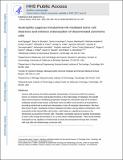| dc.contributor.author | Brooks, M. W. | |
| dc.contributor.author | Ardolino, M. | |
| dc.contributor.author | Fessler, E. | |
| dc.contributor.author | Krall, J. A. | |
| dc.contributor.author | DeCock, J. | |
| dc.contributor.author | Iannello, A. | |
| dc.contributor.author | Iwamoto, Y. | |
| dc.contributor.author | Cortez-Retamozo, V. | |
| dc.contributor.author | Pittet, M. J. | |
| dc.contributor.author | Raulet, D. H. | |
| dc.contributor.author | Spiegel, Asaf | |
| dc.contributor.author | Houshyar, Samin | |
| dc.contributor.author | Reinhardt, Ferenc | |
| dc.contributor.author | Chen, Michelle B | |
| dc.contributor.author | Zervantonakis, Ioannis | |
| dc.contributor.author | Kamm, Roger Dale | |
| dc.contributor.author | Weinberg, Robert A | |
| dc.date.accessioned | 2018-07-13T14:50:01Z | |
| dc.date.available | 2018-07-13T14:50:01Z | |
| dc.date.issued | 2016-04 | |
| dc.identifier.issn | 2159-8274 | |
| dc.identifier.issn | 2159-8290 | |
| dc.identifier.uri | http://hdl.handle.net/1721.1/116973 | |
| dc.description.abstract | Immune cells promote the initial metastatic dissemination of carcinoma cells from primary tumors. In contrast to their well-studied functions in the initial stages of metastasis, the specific roles of immunocytes in facilitating progression through the critical later steps of the invasion–metastasis cascade remain poorly understood. Here, we define novel functions of neutrophils in promoting intraluminal survival and extravasation at sites of metastatic dissemination. We show that CD11b+/Ly6G+neutrophils enhance metastasis formation via two distinct mechanisms. First, neutrophils inhibit natural killer cell function, which leads to a significant increase in the intraluminal survival time of tumor cells. Thereafter, neutrophils operate to facilitate extravasation of tumor cells through the secretion of IL1β and matrix metalloproteinases. These results identify neutrophils as key regulators of intraluminal survival and extravasation through their cross-talk with host cells and disseminating carcinoma cells. SIGNIFICANCE: This study provides important insights into the systemic contributions of neutrophils to cancer metastasis by identifying how neutrophils facilitate intermediate steps of the invasion–metastasis cascade. We demonstrate that neutrophils suppress natural killer cell activity and increase extravasation of tumor cells. | en_US |
| dc.description.sponsorship | Human Frontier Science Program (Strasbourg, France) (fellowship LT00728/2008-L) | en_US |
| dc.description.sponsorship | Charles King Trust Foundation | en_US |
| dc.description.sponsorship | Massachusetts Institute of Technology. Ludwig Center for Cancer Research | en_US |
| dc.description.sponsorship | Cancer Research Institute (New York, N.Y.) (Irvington Fellowship) | en_US |
| dc.description.sponsorship | National Institutes of Health (U.S.) (grant P01 CA080111) | en_US |
| dc.description.sponsorship | National Institutes of Health (U.S.) (grant CA163109) | en_US |
| dc.publisher | American Association for Cancer Research (AACR) | en_US |
| dc.relation.isversionof | http://dx.doi.org/10.1158/2159-8290.CD-15-1157 | en_US |
| dc.rights | Creative Commons Attribution-Noncommercial-Share Alike | en_US |
| dc.rights.uri | http://creativecommons.org/licenses/by-nc-sa/4.0/ | en_US |
| dc.source | PMC | en_US |
| dc.title | Neutrophils Suppress Intraluminal NK Cell-Mediated Tumor Cell Clearance and Enhance Extravasation of Disseminated Carcinoma Cells | en_US |
| dc.type | Article | en_US |
| dc.identifier.citation | Spiegel, A., M. W. Brooks, S. Houshyar, F. Reinhardt, M. Ardolino, E. Fessler, M. B. Chen, et al. “Neutrophils Suppress Intraluminal NK Cell-Mediated Tumor Cell Clearance and Enhance Extravasation of Disseminated Carcinoma Cells.” Cancer Discovery 6, no. 6 (April 12, 2016): 630–649. | en_US |
| dc.contributor.department | Massachusetts Institute of Technology. Department of Biological Engineering | en_US |
| dc.contributor.department | Massachusetts Institute of Technology. Department of Biology | en_US |
| dc.contributor.department | Massachusetts Institute of Technology. Department of Brain and Cognitive Sciences | en_US |
| dc.contributor.department | Massachusetts Institute of Technology. Department of Mechanical Engineering | en_US |
| dc.contributor.department | Massachusetts Institute of Technology. Division of Comparative Medicine | en_US |
| dc.contributor.mitauthor | Spiegel, Asaf | |
| dc.contributor.mitauthor | Houshyar, Samin | |
| dc.contributor.mitauthor | Reinhardt, Ferenc | |
| dc.contributor.mitauthor | Chen, Michelle B | |
| dc.contributor.mitauthor | Zervantonakis, Ioannis | |
| dc.contributor.mitauthor | Kamm, Roger Dale | |
| dc.contributor.mitauthor | Weinberg, Robert A | |
| dc.relation.journal | Cancer Discovery | en_US |
| dc.eprint.version | Author's final manuscript | en_US |
| dc.type.uri | http://purl.org/eprint/type/JournalArticle | en_US |
| eprint.status | http://purl.org/eprint/status/PeerReviewed | en_US |
| dc.date.updated | 2018-07-12T16:13:10Z | |
| dspace.orderedauthors | Spiegel, A.; Brooks, M. W.; Houshyar, S.; Reinhardt, F.; Ardolino, M.; Fessler, E.; Chen, M. B.; Krall, J. A.; DeCock, J.; Zervantonakis, I. K.; Iannello, A.; Iwamoto, Y.; Cortez-Retamozo, V.; Kamm, R. D.; Pittet, M. J.; Raulet, D. H.; Weinberg, R. A. | en_US |
| dspace.embargo.terms | N | en_US |
| dc.identifier.orcid | https://orcid.org/0000-0001-5418-5133 | |
| dc.identifier.orcid | https://orcid.org/0000-0002-7232-304X | |
| dc.identifier.orcid | https://orcid.org/0000-0002-0895-3557 | |
| mit.license | OPEN_ACCESS_POLICY | en_US |
